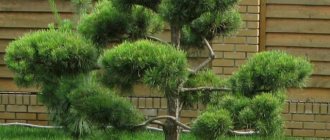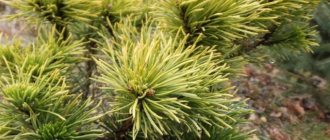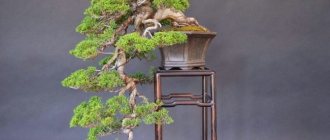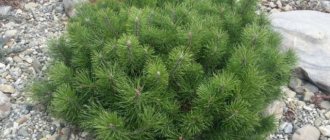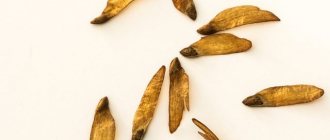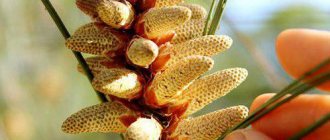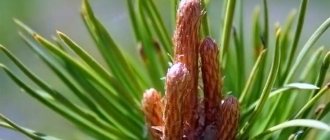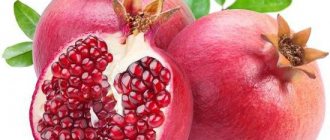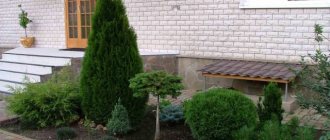Growth rate
There are about 16 species of pine trees in Russia. These conifers grow relatively quickly and grow from 2 to 20 meters in height. The annual growth in cm depends on the type of plant, but the largest number of centimeters is observed at the initial stage of tree development. At a later time, starting from the fifth year of the seedling’s life, the increase in height is no longer so impressive. Let's consider the main periods of pine life and the corresponding growth rate.
From germination to 5 years
A tiny sprout measuring 5 cm is a whole year of life for a young pine. Tender plants have not yet become strong enough and require special care. In the first years of its life, it is recommended to water the pine tree regularly and expose it to the sun, since the sprouts are unlikely to develop well in the shade. The root system is still tender and fragile, so the seedlings are not touched for two years.
In the third year, the sprouts are replanted to stimulate the growth of the root system. Until the moment of planting, the roots of young pines are fragile and poorly adapted to life in open ground. Seedlings are planted at a distance of 20 cm from each other. After transplantation, their annual growth should be about 15 cm.
They are still far from maturity, because they will be ready for transplantation to a permanent place of residence only at the age of 4 years, when they reach a height of 0.5 m. At five years, seedlings reach a size of 80-90 cm
From 5 years to 50 years
Most pines are fast-growing species. This must be taken into account when choosing a tree for your personal plot, since some specimens are already capable of becoming real giants at the age of 20-30 years.
From 5 to 10 years, many pines give a decent increase: about 0.5 m in height. Older specimens are even larger - they grow up to 1 m in height per year. After fruiting begins, tree growth slows down. After 30-50 years, trees begin to grow more in width than in height, and the crown becomes more spreading. Many species grow up to 300 years or more without reducing their growth rate. Record holders among the breed have been registered who have lived for 5 thousand years. Therefore, for landscape design of a small area, it is better to pay attention to the dwarf species of this breed. For example, the mountain pine “Gnome” has a pyramidal crown up to 2 m high .
Cedar growth periods
Fruiting of Pinus sibirica (belonging to the genus Pine) begins no earlier than after 40 years, and sometimes even after 80. Seed production in different years is either abundant or not. The increase during the first five years is small. Over time, it begins to accelerate.
How quickly do seeds germinate?
Seeds for germination should be prepared - stratified . Then plant them. In this case, they will germinate quite quickly - in a month or a month and a half. If the seed is not processed, then the sprouts will appear only next spring when sowing in April or May. If seed propagation is carried out in open ground in the fall, then in the spring the cedar will certainly germinate.
How fast does a seedling grow?
The growth rate of seedlings is influenced by the following factors:
- plant quality;
- the presence of root damage and its magnitude;
- climate of the germination region and even natural conditions at the time of planting;
- soil properties and level of fertility;
- providing care;
- air humidity;
- development near plants that are compatible or incompatible with the tree;
- influence of insects and rodents.
In the first annual life cycle, the plant has a height of about 3 cm; in the next, it can grow two or more times higher. The average growth is 3–5 cm. Thus, by the age of four years the seedling reaches two or three tens of centimeters.
At what age does the first lump appear?
The appearance of the first cone depends entirely on the place in which the tree grows. In dense forests, fruiting does not begin soon - after 60–70 years, or even more. If Pinus sibirica grows in open space, the fruits may appear much earlier - at about 15–20 years of age. On average, the plant bears fruit at the age of 25–30 years.
How does an adult cedar grow?
During the first five years, cedar growth is slow, the tree reaches a height of 25–35 cm. In ten years it can grow up to 1.5 m. But from the age of 15, the growth rate increases and in 12 months it gives the same figure - 15–35 cm During this period of life, fruiting begins if the coniferous plant is planted in a space free for development and the necessary care is provided for it.
What influences?
First of all, the growth rate is affected by the pine species. There are faster-growing specimens, such as Scots pine and Weymouth, and species that are not in a hurry - Strict pine.
The growth and development of a tree is greatly influenced by growing conditions, although pine is considered one of the most unpretentious plants. If you keep the pine tree in the shade, at first it will produce higher growth rates, but then they will decrease. Young plants should also not be left without watering. Lack of the proper amount of moisture leads to the growth and development of the tree stopping.
When determining a planting location, it is worth considering the optimal distance from other plants. In the shade and in close proximity, pine trees will not grow as productively as they could. Birches, firs, and junipers will be good neighbors.
When transplanting seedlings and large plants, a temporary stop in growth may occur. In this way, the pine will compensate for damage to the root system and grow new roots instead of lost ones. In the first five years of life, it is advisable to cover the seedlings with spruce branches or agrofibre for the winter to avoid frostbite and branches breaking off with snow.
The life expectancy of a pine tree and its growth are affected by the level of groundwater. If it is higher than 2 m from the surface, then this impairs the aeration of the roots, which directly affects the growth of the tree.
Good plant development also ensures optimal organo-mineral composition of the soil. A sufficient amount of microelements useful for pine can cause a good growth rate of the tree.
Many climatic conditions also have a negative impact on the growth of pine. For example, sudden changes in temperature, high humidity, strong winds and other factors.
Various pests have a strong negative impact on the development of pine and the longevity of the tree. It is necessary to regularly inspect the trunk and crowns of the conifer in order to notice in time the beginning signs of damage.
How to understand that conifers do not have enough fertilizers?
Evergreen trees are unpretentious to the place where they grow and do not require regular fertilizing. Due to the fact that they do not have leaves that fall in the fall, the plantings are able to accumulate and retain micronutrients.
It is recommended to regularly fertilize young conifers in the spring only for the first ten years after they are planted (or transplanted to a new place). In the future, the procedure is performed only when there is a pronounced deficiency of nutrients necessary for the growth of green mass.
The following phenomena are signs of trouble in coniferous trees and shrubs:
- slowing down the growth of the trunk in height;
- suspension of tree development in thickness;
- branches become sparse;
- the needles turn pale, turn yellow, dry out and fall off;
- excessive release of resin occurs;
- death of the buds and apex is observed;
- The seedlings take root poorly and hardly grow.
Evergreens are very demanding on the chemical composition of fertilizers and do not tolerate organic fertilizers well.
What to feed?
Growing a pine tree is quite simple, but you need to know that in the first two years of the plant’s life it must be fertilized. If there is a lack of nutrients, pine loses its attractive appearance: the needles may turn yellow and fall off. In addition to the loss of decorative properties, the tree can stop its growth. To restore the pine tree's beauty and ability to develop, the plant must be fed. The following options are suitable for these purposes.
- In order to accelerate the growth of a young plant, rotted compost or biological humus should be added to the soil. When choosing a universal fertilizer for pine trees, pay attention to the composition: it must contain at least 10 elements. For young plants, it is better to use liquid fertilizers: they are absorbed faster than granular ones.
- Good growth accelerators for pine trees are preparations such as epin and zircon. They mobilize the plant and, due to its internal reserves, accelerate growth. However, such solutions can deplete the plant, so it is recommended to apply them in combination with vitamin and mineral supplements.
- For pine trees living on poor soils, root feeding is required. Traditionally it is applied in spring or autumn. Stem injections of immunostimulants and growth stimulants will also have a good effect on the growth and development of the plant.
- A universal fertilizer that will affect the growth and development of pine in a positive direction includes “Green Guy”. Fertilizer is applied around the trunk at the rate of 25 g per cubic meter.
- There is also a drug with the same name - a growth activator for conifers. It helps the tree become more resilient, and also creates the preconditions for the development of beneficial microbiota in the pine growth zone. It comes in both liquid and dry form.
It is important not to overfeed the plant, as excess minerals will cause stress in the pine tree, and the tree will survive the winter much worse. Pine trees older than two years of age are usually not fed, as they become completely unpretentious in care. To improve the growing conditions of pine trees, their fallen needles are not removed, since they form a protective layer on the surface of the earth, and useful substances and microbiota accumulate in it.
How to speed up the process?
But there are also those who would like to see a mature spruce on their site as quickly as possible. In this case, it is worth choosing varieties of fast-growing trees. These include seedlings that grow actively in the first years after planting, and then growth slows down.
There are rules to promote accelerated tree growth.
- You should not buy large seedlings. The larger the seedling (2.5-3 m), the longer it will take to get used to new conditions, that is, get sick. As a result, a meter-long Christmas tree planted nearby can overtake its overgrown neighbor.
- Conifers are planted in the spring. The landing site should be sunny. But the needles are afraid of the active spring sun, so it is recommended to cover young seedlings with natural light fabrics from spring until the heat subsides to protect the tree from burns. Or use the drug “Ecoberin” for sunburn of pine needles. In the spring, as soon as you can approach the Christmas tree, it is sprayed with a solution that consists of 2 grains of the drug, thoroughly dissolved in 100 ml of water. After dissolution, the concentrate is added to 1 liter of water and applied to the needles.
- During the period of active growth, Christmas trees need regular weekly watering. But to avoid excess moisture, before each watering it is recommended to check the soil moisture by slightly stirring the soil.
- The tree absorbs moisture and nutrients not through large roots, but through root hairs, of which spruce trees have a lot. On the one hand, in order for fertilizer to reach the root system more quickly, the soil must be loose. On the other hand, 80% of seedling growth problems are due to root hairs being accidentally cut off while digging the soil. Naturally, in this case, plant growth slows down. The tree really needs loosening, but it must be done extremely carefully.
- To rid the seedling of competitors for moisture consumption and fertilizing, as well as to free the root system from unwanted interference, it is necessary to regularly remove weeds around the trunk at a distance of approximately 1 m. In the forest, fallen leaves and needles help to avoid unwanted competitors. In a garden plot, mulch can fulfill this role: it will protect against excess evaporation, weeds, and temperature changes. It will also provide organic nutrients. You can mulch with straw, chopped leaves, wood chips, bark, pine needles, and ready-made compost. But there must be a distance of several centimeters between the mulch layer and the trunk to reduce unnecessary moisture in the bark.
- Any damage to the bark will cause the tree to waste energy fighting the wound. This means growing slower. If rodents, dogs, rabbits, and roe deer feel at ease on the site, then the trunk must be protected (with mesh, roofing felt, plastic, burlap). This is especially important in winter, when hungry animals are looking for food. But during the formation of the crown, the branches are also damaged. Any cut or wound must be treated with garden varnish. If signs of rotting are noticed, then such branches must be cut off.
- Already in the nursery, the seedlings will receive the first portion of growth accelerators. Such stimulants will help the plant to better adapt to a new place and launch its active growing season. For better rooting, use, for example, “Kornevin”. The next feeding is carried out no earlier than a month after transplantation. And then, until August, every two weeks they perform foliar feeding (water the plant from above) with chelated fertilizer complexes. It is enough to apply other types of complex fertilizers once a season, for example, Bona Forte “Coniferous”. Autumn feeding is carried out with products labeled “autumn”.
We suggest you read: Which trees are best to plant on the site?
How to stop the growth?
The growth of a pine tree in height can be a real problem, because the tree grows very quickly, and this is not always good, especially for a small summer cottage. It is quite possible to limit the growth of a tree if you know how to do it correctly. You can get a spreading crown and a shorter trunk by adjusting the central shoot.
Adjusting the growth of pine is done simply by pinching the top shoot, popularly called a candle. This can be done on seedlings that have already formed 3 levels of branches. Very young plants should be pinched only in cases of extreme necessity, and it is better to wait until they are 4-5 years old. The procedure is carried out in spring or autumn.
To learn how to care for pine, watch the following video.
How to restrain the growth of pine trees on a site
In order to prevent trees from growing too tall on the site, it is necessary to maintain the height of the pines within the acceptable range so that they do not create a lot of shade and do not interfere with other plants.
The growth of the crown in height and width is due to the annual appearance of young shoots, which are formed on the tops of the branches of the previous year in the form of 2-3 new buds.
In the spring they produce young shoots, colloquially called “candles.” By cutting or pinching them off, they restrain the growth of the tree and regulate its size.
In order to restrain the growth of a pine tree, pruning should begin when 3-4 levels of strong branches appear on the tree. Already 1 year after planting the seedling in open ground, you can begin to form a crown.
How is pruning done?
To do this, break out the longest “candle” in a bunch of new shoots, which is the main shoot of the next season and is responsible for the continued growth of the pine in height.
The remaining shoots are shortened. Depending on the result you want to get, 3 or 4 parts are plucked off from the tops. The shorter the shoots, the better the crown will develop and grow slower.
The growth of lateral branches is regulated in a similar way. Remove the main “candle” and pinch off the rest.
It is not recommended to use pruning shears for pruning, as they can severely damage the plant. Young needles begin to turn yellow, and the decorative qualities of the pine deteriorate. It is best to do this with your fingers, carefully pinching off excess shoots. This method is used by the Japanese, who are the progenitors of such a culture as bonsai. Regardless of the height and number of shoots on the tree, they slowly and carefully pinch them with their fingers.
When pruning a pine tree, you need to ensure that all shoots are the same length. Even if the branches are too short, they must be pinched, as this promotes the formation of new young buds.
Growth rate of various pine trees
About 16 varieties of pine trees grow on the territory of the Russian Federation. These trees grow quickly and their height can vary from 2 to 20 m depending on the species. Knowing how quickly pine grows, you can choose a tree for planting in areas of different sizes.
From first shoots to 5 years
In 1 year, depending on the type, pine can grow by 5 cm, and the greatest growth occurs at the very beginning of its development. Since young plants have not yet become strong, they should be watered regularly and exposed to sunlight. In the shade, the sprouts will not be able to develop properly. In order not to damage the root system, it should not be touched for the first 2 years.
Pine tree care
You only need to care for the tree in the first two years after planting. In spring, a full range of mineral fertilizers is applied. Seedlings are watered rarely, 1-2 times a week with up to 30 liters of water at the root.
Pine forest
After 3 years of life, you don’t have to worry about watering. An adult plant is not fed or watered - from 5 years of age. It is not recommended to remove pine litter. It forms mulch, which the tree needs to retain moisture and obtain nutrients.
Some species are covered with spruce branches for the winter, and overgrown crowns are tied up so that the snow does not break the branches. In spring, young seedlings are shaded from direct sunlight. They do this until the age of 5. In the first year of life, the soil around the tree is weeded and mulched.
Crown trimming is done only when forming decorative figures. For a more luxuriant crown, spring shoots are pinched by 1/3. Otherwise, pine does not require special care.
Expert opinion
Yulia Yurievna
I have a large garden and vegetable garden, several greenhouses. I love modern methods of cultivating plants and mulching the soil, and I share my experience.
Ask a Question
We would like to note that although litter is a natural mulching agent, it is still better to remove it. The fact is that fungal spores often develop in it, which subsequently infect the coniferous plant. It is especially dangerous to leave such garbage when preparing for wintering. It is better to use sawdust, humus or peat instead of pine litter. They will also help retain moisture and heat in the soil, but without harm to the plant. As for pruning, we should not forget that its main purpose is not only the formation of the crown, but also rehabilitation. It is imperative to remove dry, diseased branches that grow inward or thicken the crown.
Scots pine
Scots pine (Pinus sylvéstris) is a tree distributed throughout Eurasia, from Scandinavia to China. In Russia it grows everywhere, in coniferous and mixed forests. Pine has been actively used in landscape design since the first half of the 19th century.
According to the old classification, Scots pine belonged to gymnosperms, that is, it does not have flowers and the seeds are located not in a container - the fruit, but openly. Now they are classified as the Coniferous department. The seeds are lionfish with a long wing and are formed in ovoid female cones, which are located in the upper part of the crown. Male spike-shaped strobili are formed at the base of young shoots.
Trees that grow slowly
Just like trees that grow quickly, there are also individuals that grow at a slow pace. Over the course of a year, they grow by about 15-20 centimeters, or even less. These are the forest pear apple tree, pistachio tree and oriental thuja, boxwood and blunt cypress, dwarf willow, Siberian pine and yew.
p, blockquote 5,0,0,0,0 —> p, blockquote 6,0,0,0,1 —>
As soon as a tree's growth slows down, it gains trunk mass. This happens because older trees absorb more CO2 and therefore gain weight. As a result, we can conclude that young trees are actively growing in height, and old ones in width. These processes depend on the specific tree species and environmental conditions.
Scots pine (Pinus sylvéstris) is a tree distributed throughout Eurasia, from Scandinavia to China. In Russia it grows everywhere, in coniferous and mixed forests. Pine has been actively used in landscape design since the first half of the 19th century.
According to the old classification, Scots pine belonged to gymnosperms, that is, it does not have flowers and the seeds are located not in a container - the fruit, but openly. Now they are classified as the Coniferous department. The seeds are lionfish with a long wing and are formed in ovoid female cones, which are located in the upper part of the crown. Male spike-shaped strobili are formed at the base of young shoots.
Trunk and crown of pine
The trunk is covered with scaly bark, and in the lower part these scales form thick plates. The outer layer comes off quite easily - this is a kind of protection from insect pests that lay their eggs or overwinter under the bark. The trunk is covered with scaly bark of brown-beige color, and in the lower part these scales form thick plates. The outer layer comes off quite easily - this is a kind of protection from insect pests that lay their eggs or overwinter under the bark. Under the influence of the wind, trees sway, partially shedding scales of bark, exposing the shelter of pests. The branches are green in the first year and then turn brown. The branches are green in the first year and then turn brown.
The wide legs of Scots pine consist of horizontally located branches, the needles on which are arranged in pairs and have a length of 3 to 9 cm. The edges of the needles have small teeth, the upper part of the needle is convex, the lower part is concave, forming a groove.
The crown diameter of Scots pine varies depending on the age and conditions in which it grows. In adult plants, the length of the lower, oldest branches can reach up to two meters. As a rule, if there is little competition between tall plants, they do not shade each other, and the crown width is greater. Conversely, if a pine tree grows in a dense forest, then it grows taller because it strives to receive more sunlight.
How and when to fertilize pine trees?
The gardener's golden rule is: it is better to underfeed than to overfeed. This applies primarily to pine trees. It can also be said that it is better not to use pine nutritional supplements at all than to do it incorrectly. In general, each gardener decides the issue of fertilizing pine trees in his own way: young seedlings up to two years old require mandatory feeding; in the future, the tree may need enough organic fertilizers from the coniferous litter formed at the roots.
The first time fertilizing is applied immediately before planting the seedling, in the top layer of soil. For every square meter you need one bucket of humus and 30–50 g of potassium phosphate fertilizer. It is advisable to mulch the soil using a litter of leaves, twigs, moss and pine needles; you can also add peat chips and wood chips.
Granular mineral supplements tend to have a long-lasting effect, while liquid ones are absorbed quickly. For seedlings, it is enough to apply 30–40 g of mineral fertilizers per square meter in the under-stem circle in the spring, once a year. Mature trees are fed twice a year: in May, when active shoot growth begins, and in August, before the winter season. Compost or vermicompost is added in an amount of 3–5 kg per square meter.
Witch's broom on the crown of a pine tree
The pine crown sometimes forms a so-called “witch’s broom”. These formations arise from dormant buds, which the tree needs as a reserve to restore lost parts of the crown. A witch's broom appears in the form of many thin branches of short length with short needles. In this way, a cluster is formed that resembles a ball in shape.
The cause of the witch's broom has not been fully elucidated, but the processes occurring during this process have been well studied. Under the influence of viruses, bacteria or other factors, mutations appear like a cancerous tumor, which lead to the growth of plant tissue.
In pine, these mutations can lead to the formation of viable forms, which is used in breeding and landscape design. A witch's broom is grafted onto the trunk of a young pine tree and, as a result, an interesting dwarf pine with a rounded crown is obtained. Such varieties are capable of bearing fruit, and some of the seedlings also inherit a mutation, while others grow into ordinary tall trees.
How fast does Scots pine grow?
The annual growth of pines depends on age and variety. In the wild variety, in the first few years the trunk lengthens by 10 cm. At the age of five to ten years, the annual growth averages about 30-40 cm, and older ones are able to grow by 100 cm every year. After 30-40 years, growth begins gradually slow down and the main forces of the plant are spent on increasing the diameter of the trunk. The tallest pines grow on the Baltic coast and can reach a height of up to fifty meters. Typically the trunk length ranges from 20-30 meters.
These indicators are average, since today there are many dwarf varieties that, even at the age of ten, do not exceed two meters in height. Again, growing conditions play a big role in the development of the plant. On poor soils and in conditions of severe cold and winds, insufficient insolation, that is, in the absence of sunlight, plants are not able to grow very tall.
Pine lifespan
In North America, for example, there are real relict specimens of pine that have reached the age of 5,000 years, some live even longer - up to 9,000 years. But these are exceptions rather than the norm.
Scots pine lives for about 500 years under good growing conditions. The average lifespan of a tree of any type is from 50 to 300 years. The main conditions for good growth and long life are plenty of sun, loose soil of average fertility and clean air. Cultivars live a long time, from 50 to 100 years, sometimes even longer. There is no need to worry about the longevity of development; it will definitely be enough for one generation of a person.
Features of the root system
If we are talking about a tree like Scots pine, its description will not be complete enough without talking about the root system. Unlike many other trees, pine is plastic and its shape depends, like the shape of the crown, on growing conditions. There are four main types of root systems that are found in this plant:
- developed tap root and several lateral branches
- strongly pronounced lateral with weak core
- a dense network of short roots that do not go deep into the soil
- almost superficial developed root system.
The looser and well-drained the soil in the area where Scots pine grows, the stronger the taproot. On very dense soils, for example, on stones with a small amount of soil, the tree is forced to form a kind of “plate” that can support a heavy crown and a high trunk, especially under strong wind loads. In addition, since the main function of the root is to supply the plant with water, a root system spreading widely in all directions is characteristic of areas with deep groundwater.
Where does pine grow
The range of pine trees extends from the Arctic to the equator. Scots pine is more common in Siberia and Europe. It always grows well in sandy and sandy loam soil, forming pine forests; it is less common on peat or clay soil. In Russia there are 16 wild and 73 planted species of this genus. Siberian pine plantations cover almost 5.7 million km².
This type of conifer can also be found in Spain, Great Britain, China and Mongolia. The plant is unpretentious to soil conditions and can grow in environments unsuitable for other species: marshy and sandy areas. There are pine plantations both in their pure form and with other types of trees.
What is mycorrhiza
Transplanting pine trees from the forest is often unsuccessful for one reason: when moving the tree to a new place, the formation, which plays an important role in the life of the tree, is disrupted. This formation is mycorrhiza - a symbiosis of fungal hyphae and tree roots. In such an alliance, for the most part, mutual benefit reigns.
Although pine grows quickly, enough carbohydrates are deposited in its roots, which are necessary for fungi to reproduce, unlike, for example, poplar. Mushrooms, in turn, improve the saturation of the plant with micro- and macroelements. In particular, the concentration of potassium increases by 75%, and nitrogen by 86%. The benefit to the tree is best seen when studying the absorption of phosphorus, which was absorbed 234% more actively in pines with mycorrhiza than without it.
It is also interesting that the fungi that have settled on the roots of pine trees and formed peculiar covers are able to protect the root system from pathogenic fungi, bacteria and viruses. And due to the fact that hyphae sprout not only near the tree, but can stretch for tens of meters, an exchange of nutrients occurs between neighboring pines.
In a stressful situation, many trees, including Scots pine, can form phytoalexins - natural antibiotics. It turned out that mycorrhiza-forming fungi can stimulate pine to synthesize these substances and, thus, activate the plant’s immunity.
The symbiosis of fungi and roots is in balance up to a certain point. If the tree is weak and begins to die, then the hyphae of the fungus penetrate deep into the root and destroy it, accelerating death. At the same time, if the mushroom cannot withstand the influence of some unfavorable factors, the pine begins to dissolve and “digest” it, absorbing all the nutrients. Thus, in nature, the strongest survive, capable of producing good offspring.
What compounds can harm evergreens?
When choosing autumn fertilizer for coniferous trees, some gardeners prefer superphosphate for the large amount of phosphorus in its composition, which improves plant immunity and preserves the color of needles, but this fertilizer is often sold as part of a fertilizer mixture containing a nitrogen component. Therefore, it is preferable to choose special compositions for pine, fir and spruce, which contain a balanced complex of magnesium, potassium and phosphorus without nitrogen.
In their natural environment, spruce and pine trees can withstand Siberian frosts down to -65 degrees, since they are not fertilized and do not violate natural immunity. Therefore, in the countryside, pine and fir trees cannot be fertilized with manure, even if the mullein is well diluted with water. In addition to the fact that such fertilizing for coniferous trees can destroy the plant by damaging its root system, nitrogen stimulates the vigorous growth of greenery, which will not have time to become lignified before winter, as a result of which the tops will freeze.
Tree growth rate. Growth Chart and Latest Research
Trees are among the longest-living organisms on Earth and they constantly produce new cells that form what are called annual growth rings or annual growth rings over the course of a year. These growth rings indicate the amount of wood grown during one growing season. And according to recent research by ecologists, the overall growth rate of most tree species only increases with age. However, regarding the rate of growth in height, a slightly different principle applies. It should be noted that the growth rate of a tree can be increased with proper care; information about this can be found in the article “On how to accelerate the growth of trees and shrubs. 6 little secrets."
Fertilizers for coniferous trees
No plant is capable of producing as much oxygen as evergreen trees.
It is not for nothing that people choose forests where spruce, pine, and fir trees grow to treat the respiratory system. Sanatoriums, which are located in pine forests, have amazing properties to heal the body thanks to the phytoncides found in the resin of these plants. You can recreate a piece of forest on your summer cottage by planting the types of trees you like. Before this, you need to familiarize yourself with the growing methods and nutritional system of conifers. Feeding spruce, thuja and other tree species with needles must be done carefully. These breeds are unpretentious in nutrition and excess feeding can only harm them. When growing on a site for beauty, you need to know what to feed the conifers and when is the best time to do it. Professionals advise not to be too zealous with mineral supplements; it is better not to use anything at all than to use it incorrectly.
Tree height growth rate
Typically, living things, including us, have a period of active growth when they are young, but as they age, growth slows down or stops altogether. The growth rate of trees in height has the same character. After a period of active growth in height, the growth rate of the tree decreases, and it begins to gain weight due to the trunk and side shoots. The figure shows the general nature of the relationship between the height of most trees and its age. The schedule is divided into three phases. 1 is the initial phase of slow growth, followed by a phase of rapid growth - 2. When the tree approaches a certain height, the growth rate drops - phase 3. Of course, time and height values will vary for each individual tree depending on the species and environmental conditions.
The general nature of the dependence of the height of most trees on age
Different types of trees grow at different rates. Depending on the growth rate, trees are usually divided into groups. In tables 1 and 2, trees are divided into groups depending on the tree's growth rate per year. Trees gain such growth rates during the active phase (between the ages of 10 and 30 years).
Table 1: Fast and Moderate Growing Trees
Very fast growing
Fast growing
Moderately growing
“Large, old trees act not just as aging carbon reservoirs, but also actively sequester large amounts of carbon compared to small trees... In some situations, one large tree can add as much carbon to the forest mass in a year as is contained in an entire medium-sized tree "
The main problem is the perception of scale. Stevenson says it's difficult to see a large tree grow because it's already huge. As the tree ages, it gains less thickness, but the larger the diameter, the greater the surface area it grows. A tree can grow in height for many years, but at a certain point it reaches its peak and then begins to increase in trunk diameter, increasing the number of branches and leaves.
The researchers write: “It is likely that rapid growth of giant trees is the global norm and may exceed 600 kg per year in the largest specimens.”
Stevenson also says that if people grew at this rate, they could weigh half a ton at middle age, and well over a ton by retirement.
The figure shows the general nature of the dependence of the growth rate of tree mass on the decimal logarithm of tree mass, given in the materials of the article.
Tree mass growth rate
As a result of human activity and other reasons, huge areas of ancient forests are being destroyed. Between 2000 and 2012, world forests decreased by 1.5 million square meters. km. In Russia, forests are being actively cut down in the Far East. Trees play a very important role in existing ecosystems, they absorb carbon dioxide and clean the air, so it is vital for us to protect forests from destruction.
Main stages of growth
Landscape designers love spruce for its decorative properties. This also applies to common spruce, Canadian or Serbian spruce. Species and varieties differ not only in color (rich green, blue spruce, black), but also in growth. Moreover, this can be either a hybrid or varietal version - a dwarf form of an ordinary spruce, or the result of the designer’s work on crown formation. Thanks to selection, there are slow-growing and fast-growing varieties.
But they all go through similar stages of growth. Until 10 years old, the tree grows very slowly. At the age of 5, the Christmas tree grows only up to 50 cm with a crown diameter of 30 cm. And only at the age of 10 does the tree begin active annual growth - 30-50 cm per year. The table below shows the growth progress of spruce in comparison with pine.
It is clear that the growth rate will vary under different conditions, and therefore the data in different sources will be different.
But the older the tree, the more it strives upward: an adult fast-growing spruce can add up to 1 m in height in a year. The average lifespan of the common spruce is 250-300 years. During this time, the small Christmas tree will turn into a 50-meter giant. This is comparable to a 16-story building.
These sizes are not suitable for every area. Therefore, many choose dwarf varieties, which do not grow so quickly (3-5 cm per year), but are very decorative.
